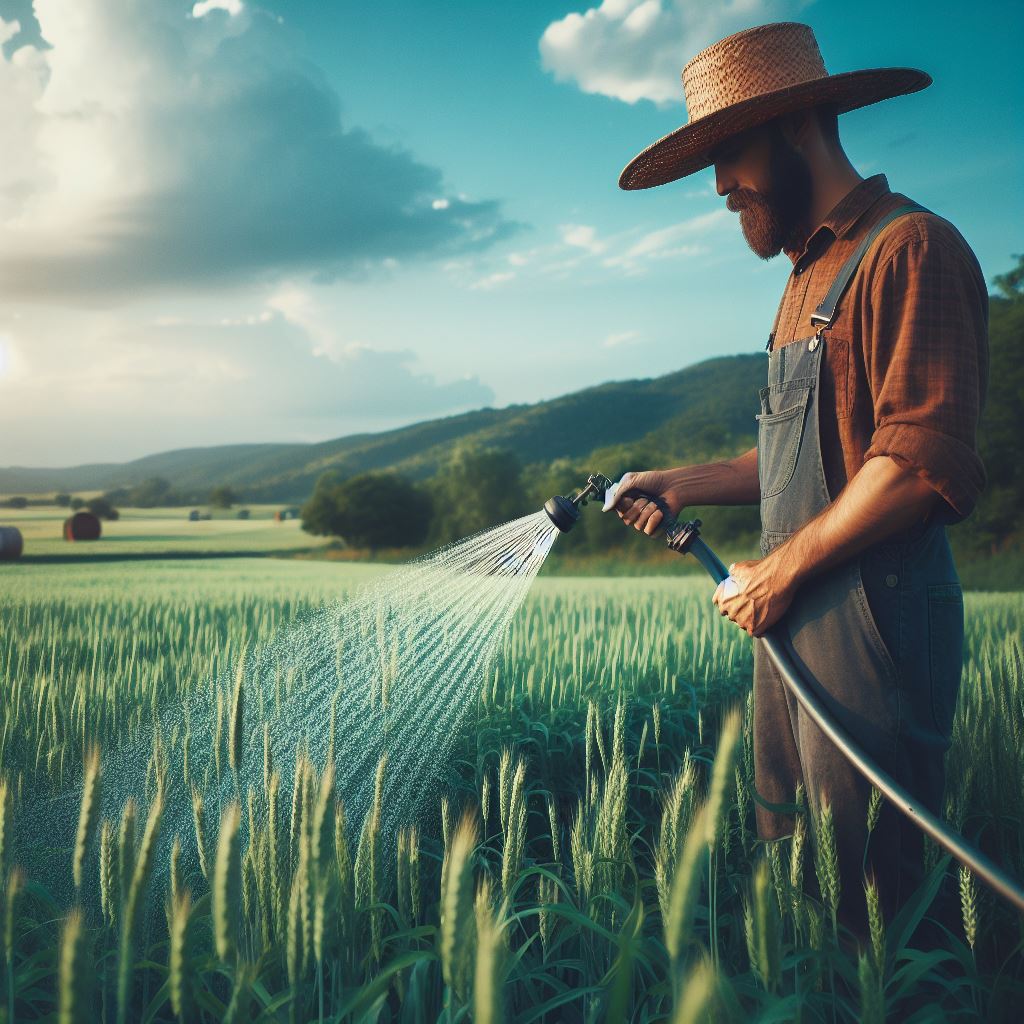Introduction
Knowing the best times to harvest corn is essential for maximizing yield and quality. By harvesting at the right time, farmers can ensure optimal maturity and flavor in the corn kernels.
In this blog section, we will explore the importance of understanding the harvest timing and highlight some key tips and tricks to achieve the best results.
Importance of knowing the best times to harvest corn
Harvesting corn at the right stage is crucial for several reasons.
Firstly, it allows farmers to achieve maximum yield, as corn reaches its peak dry matter content at specific stages.
Secondly, harvesting at optimal timing ensures the best quality corn, with ideal texture, taste, and sweetness.
Lastly, by avoiding overripening, farmers can reduce the risk of kernel damage, mold growth, and yield losses.
Brief overview of key tips and tricks
In this blog post, we will delve into essential tips and tricks for determining the best times to harvest corn. We will discuss visual indicators such as kernel development, silk color, and plant drying.
Additionally, we will explore manual assessments including kernel milk line and starch accumulation. Proper equipment selection and harvest moisture considerations will also be covered to maintain corn quality during harvest.
By following these guidelines, farmers can make informed decisions about when to harvest their corn crop, leading to optimal yields and high-quality corn.
Understanding the signs of maturity and employing the right techniques will ultimately result in a successful corn harvest and a fruitful farming season.
Understanding Corn Maturity
Corn is a crop that goes through various stages of growth and maturity before it is ready to be harvested. Monitoring the development of corn plants is crucial to ensure optimal yield and quality.
Here, we will discuss the stages of corn growth and maturity, the significance of monitoring corn development, and how to determine the maturity of corn plants.
Stages of corn growth and maturity
- Germination: The first stage in the life of a corn plant is germination. During this stage, the seed absorbs water and swells, leading to the emergence of the radicle, coleoptile, and eventually the first leaves.
- Vegetative growth: After germination, the corn plant enters a period of vegetative growth. During this stage, the plant develops roots, stems, and leaves to support its growth and prepare for reproductive development.
- Reproductive growth: The reproductive growth stage is a critical period for corn plants. It is during this phase that the plant forms tassels and silks, which are responsible for pollination and the development of ears.
- Grain fill: Once pollination occurs, the corn plant enters the grain fill stage. This period is crucial for the development and filling of the corn kernels. Adequate moisture and nutrient availability are essential during this stage to ensure optimal yield.
Significance of monitoring corn development
- Timing harvest: Monitoring corn development allows farmers to determine the best time to harvest. Harvesting too early can result in lower yield and reduced grain quality, while harvesting too late can lead to shattering and loss of yield.
- Yield estimation: By monitoring corn growth and maturity, farmers can estimate the potential yield of their crop. This information is valuable for managing storage space, planning harvesting equipment, and predicting market supply.
- Pest and disease management: Monitoring corn development helps identify potential pest and disease issues. Early detection allows farmers to take timely action, minimizing crop damage and ensuring healthy plant growth.
How to determine the maturity of corn plants
- Days to maturity: Each corn variety has a specific number of days required to reach maturity. Monitoring the growing degree days (GDD) helps estimate the maturity of corn plants. GDD is calculated based on temperature and crop development.
- Kernel milk line: The kernel milk line refers to the line that forms on individual kernels as they mature. This line moves from the top to the bottom of the kernel, indicating the maturity stage. Harvesting can be done when the kernel milk line reaches the desired level, depending on the intended use of the corn.
- Dry matter content: Corn plants reach maturity when they have achieved maximum dry matter content. Harvesting at this stage ensures optimal kernel moisture content for storage and processing.
In summary, understanding corn maturity is crucial for maximizing yield and quality. By monitoring corn development, farmers can time their harvests accurately, estimate yield, manage pests and diseases, and ensure optimal grain fill.
Determining the maturity of corn plants can be done through tracking days to maturity, observing the kernel milk line, and considering dry matter content. Successful corn harvests require careful attention to the different stages of corn growth and maturity.
Read: Crop Diversity Benefits Revealed
Transform Your Agribusiness
Unlock your farm's potential with expert advice tailored to your needs. Get actionable steps that drive real results.
Get StartedMonitoring Moisture Levels
When it comes to harvesting corn, monitoring the moisture levels is essential for a successful harvest. The moisture content in corn plays a crucial role in determining the ideal time for harvesting.
Farmers need to be aware of the optimal moisture levels in order to achieve maximum yield and maintain the quality of the harvested corn.
Importance of Moisture Content in Corn
Understanding the importance of moisture content is the first step in determining the best time for corn harvest. Moisture content affects the quality of the corn, as well as the ease of storage and subsequent processing.
Harvesting corn with a high moisture content can result in mold growth, poor shelf life, and decreased nutritional value. On the other hand, harvesting corn with a low moisture content can lead to brittleness and damage during handling.
Optimal Moisture Levels for Corn Harvest
To ensure optimal quality and minimal loss during storage, corn should be harvested at the right moisture content. The exact moisture level may vary depending on the specific corn variety, intended use, and storage conditions.
Generally, corn for grain should be harvested at moisture levels between 20% to 25%. This moisture range allows for easy shelling and minimizes the risk of spoilage.
Methods to Measure Moisture Content
Accurate measurement of moisture content is crucial for determining the right time to harvest corn. Here are some common methods used by farmers to measure moisture levels in corn:
- Moisture Meters: Electronic moisture meters are widely used by farmers to measure grain moisture. These handheld devices provide instant readings and are easy to use. Simply insert the probe into the corn sample, and the meter displays the moisture content.
- Microwave Oven Method: This method involves weighing a known quantity of corn, drying it in a microwave oven, and then re-weighing it to calculate moisture loss. While it may take longer than using a moisture meter, this method can be cost-effective for farmers who do not have access to electronic devices.
- Calcium Carbide Method: Farmers can also use the calcium carbide method to measure corn moisture levels. This method involves crushing a small sample of corn and adding calcium carbide pellets to create acetylene gas. The pressure generated by the gas is then measured to determine the corn’s moisture content.
In fact, monitoring moisture levels in corn is crucial for a successful harvest. Farmers need to understand the importance of moisture content and strive to achieve optimal levels for maximum yield and quality.
Utilizing methods such as moisture meters, microwave oven, or calcium carbide can help accurately measure the moisture content and determine the best time to harvest corn.
By paying attention to moisture levels, farmers can ensure a bountiful corn harvest and preserve the quality of their crop.
Read: Improving Soil: Natural Methods
Evaluating Kernel Maturity
Evaluating kernel maturity is crucial in determining the best times to harvest corn. By understanding the indicators of kernel maturity and changes in kernel color, texture, and milk line, farmers can make informed decisions.
Performing kernel maturity tests adds precision to the process.
Indicators of kernel maturity
- Kernel color: As corn matures, the kernels change color from a milky white to a deep yellow or brownish shade.
- Kernel texture: Ripe corn kernels feel firm and well-developed, while immature ones may be soft or doughy.
- Milk line: The milk line is an important indicator of maturity. On a corn kernel, it refers to the line dividing the yellow, mature endosperm from the white, immature endosperm. As corn matures, the milk line moves towards the kernel’s base, indicating higher maturity levels.
Changes in kernel color, texture, and milk line
- Color change: Observing the color transition from white to yellow or brownish gives a quick indication of corn maturity.
- Texture change: Feeling the firmness and consistency of kernels assists in assessing their maturity level.
- Milk line movement: Monitoring the milk line progression towards the kernel’s base indicates the maturity stage.
Performing kernel maturity tests
- Scrape test: Scrape the kernel with a thumbnail. If a milky substance exudes, the corn is not yet mature, but if there is no liquid, it indicates maturity.
- Dough test: Firmly squeeze the kernel between fingers. If the kernel feels doughy or gives under pressure, it is immature. A fully mature kernel feels firm and resists compression.
- Kernel starch test: Cut cross-sections of corn kernels and apply iodine. Immature kernels have a translucent appearance, while mature kernels turn dark violet-black due to higher starch content.
Evaluating kernel maturity is a crucial step in determining the optimum time to harvest corn. Indicators such as changes in color, texture, and the milk line assist in assessing corn maturity levels.
Performing kernel maturity tests, including the scrape test, dough test, and kernel starch test, adds precision to the evaluation process.
By carefully evaluating kernel maturity, farmers can ensure they harvest corn at its peak quality and yield, maximizing their harvest’s success.
Read: No-Till Farming: Pros & Cons
Assessing Drydown Rates
To determine the drydown rates of corn, farmers should consider various factors that affect the process.
Factors affecting the drydown period
Factors affecting the drydown period include weather conditions, hybrid selection, and planting density.
Weather conditions, specifically temperature and humidity, play a crucial role in corn’s drydown rate.
Warm and dry weather speeds up the process, while cool and wet conditions slow it down.
Hybrid selection is another factor to consider, as different corn varieties have varying drydown rates.
Farmers should choose hybrids that have a reputation for quick drydown to optimize the harvesting timeline.
Planting density can also influence drydown rates, with higher populations potentially leading to slower drying.
Determining the ideal drydown rate for corn
Determining the ideal drydown rate for corn depends on various factors, including intended use and moisture level.
For grain production, the ideal drydown rate is when the moisture content reaches around 15-18%.
This range ensures that kernels have dried sufficiently but still retain enough moisture for proper storage.
On the other hand, if the corn is intended for silage, a lower moisture content of around 60% is desirable.
Monitoring drydown can be done using various tools and techniques to ensure accurate assessment.
One commonly used tool is a moisture meter, which provides quick and reliable moisture level readings.
Farmers can take periodic samples from different areas of the field to ensure accurate and representative measurements.
Another technique involves visually inspecting the corn kernels for signs of dryness, such as color and texture.
Dry kernels should appear shriveled, hard, and have a yellowish color instead of the usual milky or dough-like appearance.
Regularly monitoring the weather forecast can also help farmers plan their harvesting activities accordingly.
If dry conditions are expected, farmers can prioritize fields that are closer to reaching their desired drydown rate.
Tools and techniques for monitoring drydown
Additionally, advanced technologies such as remote sensing and drone imagery can assist in monitoring crop maturity.
These tools provide real-time information on crop health, growth stage, and potential harvest timing.
Farmers can utilize this data to make informed decisions regarding the optimal timing to harvest their corn.
Overall, assessing drydown rates is essential for optimizing corn harvests. By considering factors affecting drydown, determining ideal rates, and using appropriate tools, farmers can ensure efficient and successful harvests.
Read: Sustainable Farming Myths Debunked

Keeping an Eye on Field Conditions
Impact of soil moisture and temperature on corn harvest
In order to determine the best times to harvest corn, it is crucial to monitor the soil moisture and temperature levels in the field.
Soil moisture plays a significant role in corn harvest as it affects both the quality and yield of the crop. If the soil is too dry, it can lead to stunted growth and reduced productivity.
Showcase Your Farming Business
Publish your professional farming services profile on our blog for a one-time fee of $200 and reach a dedicated audience of farmers and agribusiness owners.
Publish Your ProfileOn the other hand, excessive moisture in the soil can also be problematic as it can lead to root rot and decreased nutrient uptake. It is important to strike a balance and ensure optimum soil moisture for a successful harvest.
Similarly, temperature is another critical factor to consider. Corn requires a specific range of temperature for optimal growth and maturity. Monitoring the temperature helps determine if the crop is progressing as expected.
Ambient temperature affects the photosynthesis process, which is vital for the production of carbohydrates that contribute to grain filling. Proper temperature conditions ensure that the corn reaches its full potential.
Evaluating field conditions for harvest readiness
Prior to harvesting corn, it is essential to assess the field conditions to ensure that the crop is at its peak stage of maturity and ready for harvest.
One key indicator is the color of the corn kernels. When the kernels turn from milky white to a more opaque yellow, it indicates that the corn is nearing harvest readiness.
Another factor to consider is the moisture content of the corn. The ideal moisture content depends on the specific corn variety and the intended use of the harvested crop.
Generally, for grain corn, the moisture content should be around 25-28%. For silage corn, it should be between 60-70%. Testing the moisture content helps determine if the corn is ready for harvest.
In addition, assessing the stalk and husk conditions is crucial. A good indication of harvest readiness is when the stalks have started to dry and the husks have turned brown and dry.
Best practices for field assessment before harvesting
To ensure a successful corn harvest, following these best practices for field assessment is highly recommended:
Regularly inspect the field and monitor soil moisture levels using a soil moisture probe.
Take regular temperature measurements to track the progress of corn growth and maturity.
Monitor the color of the corn kernels to determine if they have reached the desired maturity stage.
Test the moisture content of the corn using a grain moisture tester or a microwave moisture meter.
Inspect the stalks and husks to assess if they have started to dry and turn brown.
Keep records of field observations and measurements to track the progress of the corn crop.
By keeping a close eye on field conditions, evaluating soil moisture and temperature, and utilizing best practices for field assessment, farmers can determine the optimal time for corn harvest.
This ensures maximum yield and quality, resulting in a successful corn harvest season.
Discover More: Soil Care: Reducing Disease Risks
You Might Also Like: Choosing Crops for Soil Health
Timing Harvest for Optimal Yield and Quality
Harvesting corn at the right time is crucial to ensure maximum yield and preserve quality. Balancing between maximizing yield and preserving quality requires careful consideration.
Both delayed or premature harvest can have negative impacts on corn production. To achieve optimal yield and quality, several strategies can be implemented.
Balancing between Maximizing Yield and Preserving Quality
Harvesting corn at the right time is essential for achieving a balance between maximizing yield and preserving quality.
Delaying the harvest too much can lead to yield loss as the corn may become overripe and dry, resulting in lower kernel weight.
On the other hand, harvesting too early may result in immature corn with lower yield potential and reduced kernel quality.
Impact of Delayed or Premature Harvest on Corn
Delayed harvest can lead to increased crop damage due to adverse weather conditions, such as heavy rains or hail, which can reduce grain quality and increase the risk of mold growth.
Premature harvest, when corn is not fully mature, can result in lower kernel weight, decreased starch content, and reduced overall yield.
Both delayed and premature harvests can negatively affect the profitability of corn production and compromise the quality of harvested grains.
Strategies to Achieve Optimal Yield and Quality
Regular monitoring of corn development is essential to identify the right time for harvest.
Field sampling and kernel moisture testing can help determine the ideal moisture content for harvest.
Utilizing corn maturity indicators, such as kernel milk line and dry grain texture, can assist in determining the optimal harvest time.
Considering weather forecasts and crop conditions can help plan the harvest window to avoid adverse weather events and achieve optimal drying conditions.
Efficient harvesting techniques, such as adjusting combine settings and using header attachments, can improve harvest efficiency and minimize grain losses.
Proper post-harvest handling, including timely drying, cleaning, and storage, is crucial to maintain the quality and market value of harvested corn.
Adopting integrated pest management practices can help prevent and manage pest infestations that may affect grain quality during storage.
Regular crop rotation and soil management practices can improve overall crop health and minimize disease pressure, which can subsequently impact yield and quality.
Basically, timing the harvest of corn for optimal yield and quality involves a delicate balance. Delayed or premature harvests can have negative impacts on corn production.
By implementing strategies such as monitoring corn development, utilizing maturity indicators, considering weather forecasts, and adopting efficient harvesting techniques, farmers can achieve both high yield and preserved grain quality.
Proper post-harvest handling and integrated pest management practices also play crucial roles in ensuring the quality of harvested corn. By following these guidelines, farmers can maximize their profits and contribute to a successful corn production season.
Harvesting Techniques and Equipment
Selecting the right harvesting equipment for corn:
- Combine Harvester: The most common and efficient equipment used for corn harvesting. It combines cutting, threshing, and cleaning processes in one machine.
- Header: The attachment in front of the combine harvester that cuts the corn stalks at the base, ensuring a smooth and efficient harvesting process.
- Row Crop Header: Specifically designed for corn harvesting, this header enables the combine to move smoothly through the rows, collecting corn ears efficiently.
- Corn Picker: Another option for harvesting corn, this equipment is attached to a tractor and picks the corn ears individually. However, it is less efficient compared to a combine harvester.
Proper use and setting of equipment
- Speed Adjustment: Adjust the operating speed of the equipment according to the crop conditions and the moisture content of the corn.
- Cutting Height: Set the cutting height of the header to ensure optimum yield and minimize losses. Corn should be harvested at a height that includes the ear, but not too high to leave excess stalks.
- Maintenance: Regularly maintain and lubricate the equipment to ensure its smooth operation. Any mechanical issues or malfunctions should be addressed promptly.
Handling and storage considerations during harvest
- Moisture Content: Corn should be harvested when the moisture content ranges between 20-25%. Harvesting too early may result in immature grain, while harvesting too late may lead to increased dry matter loss.
- Drying: If corn harvested has a moisture content above 15%, it needs to be dried using a grain dryer or natural air drying methods. Properly dried corn ensures longer shelf life and minimizes the risk of fungal growth.
- Storage Facilities: Corn can be stored in on-farm grain bins or commercial grain elevators. Ensure storage facilities are clean, dry, and free from pest infestations to maintain grain quality.
- Aeration: Proper aeration in storage bins can help maintain consistent temperature and moisture levels within the stored corn, reducing the risk of spoilage.
- Quality Checks: Regularly check the stored corn for signs of spoilage or insect infestation. Any affected grains should be removed immediately to prevent further damage.
By following these tips and using the right harvesting equipment, farmers can optimize the corn harvest and ensure high-quality yields. Proper maintenance and handling during harvest are essential for long-term storage and profitable marketing of the harvested corn.
Conclusion
Recap of key tips and tricks discussed
All in all, understanding the best times to harvest corn is crucial for maximizing yields and improving overall crop quality. By following the key tips and tricks discussed in this section, farmers can ensure a successful corn harvest by timing it right.
Showcase Your Farming Business
Publish your professional farming services profile on our blog for a one-time fee of $200 and reach a dedicated audience of farmers and agribusiness owners.
Publish Your ProfileThe importance of understanding the best times to harvest corn
It is important to remember the importance of monitoring the corn’s moisture content and maturity stage before harvesting. Harvesting too early or too late can result in lower yields and reduced quality.
Additionally, utilizing methods such as the milk-line test, kernel denting, and observing the color and dryness of the husks can provide valuable indicators for determining the ideal time to harvest corn.
Encouragement to apply the knowledge gained to improve corn harvests.
By applying the knowledge gained from understanding the best times to harvest corn, farmers can make informed decisions to optimize their corn harvests.
This includes planning and coordinating logistics, managing equipment requirements, and maximizing the efficiency of labor resources.
Improving corn harvests not only benefits the farmers by maximizing profits but also contributes to food security and sustainability, ensuring a consistent supply of corn for various uses and markets.
In the end, mastering the art of timing the corn harvest is a valuable skill for farmers, and with continuous learning and practice, they can achieve better results year after year.




